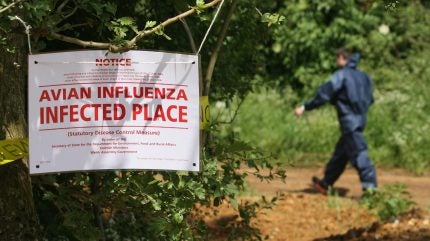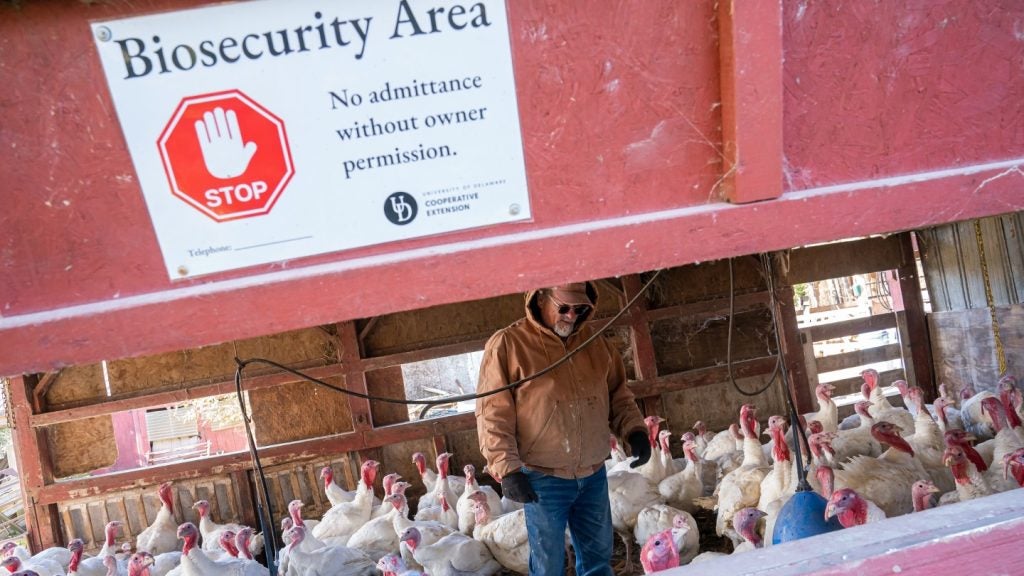
The global medical community is beginning to mobilise in response to the growing threat of pandemic posed by the H5N1 strain of avian influenza.
On 2 July, the US government chose Moderna to develop a vaccine for the zoonotic disease ravaging farms, disrupting food markets and, increasingly, infecting humans. The US Department of Health and Human Services (HHS) will provide approximately $176m in funding for the development of an mRNA-based pandemic influenza vaccine.
Across the Atlantic, Finland has become the first country to begin vaccinations for H5N1.
“Vaccinations have started this week,” Aino Pennanen, senior medical officer at Finland’s Health Ministry, tells Just Food sister site Pharmaceutical Technology. “The vaccinations are offered to people aged 18 or over who are at increased risk of avian influenza infection, such as fur farm and poultry workers, official veterinarians and laboratory workers who handle the avian influenza virus.”
Finland’s 20,000-dose operation – sufficient to vaccinate 10,000 people with two doses apiece – is part of an EU contract that has secured more than 40 million doses of preventative avian influenza vaccine in total.
The contract sees manufacturer CSL Seqirus supply a large chunk of the vaccines for 15 European countries, with an option for a further 40 million vaccines for a maximum of four years.
Experts call on the WHO to prepare for avian influenza pandemic
The US and EU’s action has been spurred by increasingly urgent warnings from industry professionals, international medical bodies and academics.
In April, the World Health Organization (WHO) said H5N1 avian influenza has pandemic potential, calling for thorough epidemiologic investigation in the case of human exposure to avian influenza.
The WHO’s chief scientist Dr Jeremy Farrar said the disease has had an extremely high mortality rate among the several hundred people known to have been infected with it since 1996.
“H5N1 is an influenza infection, predominantly started in poultry and ducks and has spread effectively over the course of the last one or two years to become a global zoonotic – animal – pandemic,” Farrar said in April.
Industry professionals have urged the WHO to prepare more effectively for a potential H5N1 pandemic than it did during the outbreak of Covid-19 in 2020.
Academics at the Washington University School of Medicine in St Louis unpacked avian influenza’s pandemic potential in a paper last month, while scientists from countries around the world this week cautioned that an H5N1 pandemic is ‘unfolding in slow motion’, Reuters reported.
The first known cases of H5N1 date as far back as 1959, with the current dominant strain having evolved at the turn of this century. H5N1 has now been detected on every continent – including Antarctica – spreading from poultry farms to cattle herds to domestic pets. As of 1 July, more than 97 million farmed birds have been infected across 48 US states.
While no human-to-human H5N1 transmission has been recorded, animal-to-human transmission is becoming increasingly prevalent. Total infections since 2003 hit 889 in June, of which 463 were fatal. The majority have been in Cambodia, China, Laos and Vietnam. There have also been five human cases reported in the US.
CDC declares “moderate” risk of avian influenza pandemic
The most recent known US case of H5N1 avian influenza, identified by Centers for Disease Control and Prevention (CDC) in Colorado earlier this week (3 July), came through exposure to dairy cows that had tested positive for the disease.
A spokesperson tells Pharmaceutical Technology CDC believes circulating H5N1 viruses pose a moderate risk of pandemic emergence and of having an impact on public health should sustained human-to-human spread occur.
CDC assesses the potential pandemic risk of novel influenza viruses with its Influenza Risk Assessment Tool (IRAT).
“A new IRAT is underway for the virus isolated from the human infection in Texas,” the CDC spokesperson says. “The decision is based largely on the fact that the virus has emerged in a new host in the United States.”

During its last IRAT last July, CDC concluded the H5N1 virus was associated with an outbreak at a mink farm in Spain in 2022.
Experts will use the results from these latest IRAT studies on ferret transmissibility and pathogenicity to inform the overall IRAT risk assessment score.
“While CDC believes that the immediate threat to the public posed by this virus remains low, the outcome of the IRAT will assess potential public health risk that this virus will change to cause human-to-human spread and the potential public health impact that would occur if that were to happen,” the spokesperson adds. “This would help inform pandemic preparedness planning.”
Meat, eggs and milk supply chains under strain
A comparatively trivial headline-snatcher in this week’s press has been a forced shortening of breakfast serving hours in Australian McDonald’s franchises due to H5N1-inflicted egg shortages.
But the reports point to more serious concerns about supply chains in the food industry.
In the past two months, several strains of avian influenza have been detected in at least eleven poultry facilities across south-east Australia – a trend indicative of the thousands of farms struggling with infections globally.
More than 97 million wild aquatic birds and commercial poultry have been affected by H5N1 in the US alone, causing poultry and egg prices to rise drastically.
In early April, a Texas facility belonging to egg-producing heavyweight Cal-Maine Foods ceased production temporarily following the detection of the flu. Some 1.6m laying hens and 337,000 pullets were culled as a result.
A US Department of Agriculture (USDA) spokesperson says, however, it remains confident the meat supply is safe, adding that, to date, the agency has received no reports of clinical signs in cattle other than dairy cattle.
The US Food and Drug Association (FDA) says it has conducted studies that provide strong assurances that the commercial milk supply is safe.
Meanwhile, in the UK, the dairy industry was slow to identify the outbreak of avian influenza among dairy cows, with the Food Standards Agency (FSA) confirming its presence in raw milk in April. Nonetheless, the UK-based FDA still identifies H5N1’s risk as ‘very low’.
All eyes in the pharmaceutical, medical and food industries will be fixed on the rollout of human vaccines, first in Finland, then more widely in Europe, then the US.
It remains to be seen whether the global community has learnt how to nip any potential pandemic in the bud from the uncoordinated, unequitable distribution of Covid-19 vaccines.



